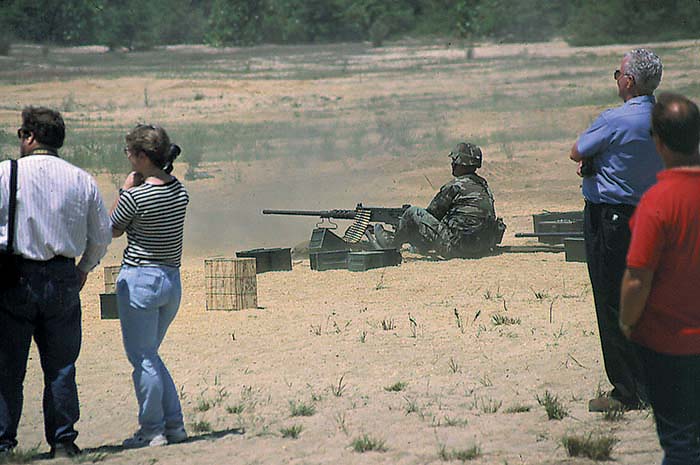.50 BMG pumps some rounds down range during the 42nd Inf. Div. demo at the NDIA SA 1999.
By Robert Bruce
Infantry Weapons Today and Tomorrow Traditionally featuring the latest military small arms, ammunition, sighting systems and related items, the NDIA’s Small Arms Section annual meeting is probably the best place in the world to get cutting edge but just barely unclassified info on what armaments American infantrymen are likely to be carrying on the battlefield of the early 21st century.
Closed to the Public
This year’s annual meeting was held on June 21st through the 24th, hosted by the US Army’s ARMAMENT RESEARCH, DEVELOPMENT and ENGINEERING COMMAND (ARDEC) at the impressive Picatinny Hilton Hotel near its headquarters at famous Picatinny Arsenal, New Jersey.
Unlike S.H.O.T. and other firearms industry trade shows which are primarily set up to sell a specific product line to wholesale and retail dealers, NDIA’s Small Arms Section meetings are generally closed to the public and accessible only to those professionals with bonafide credentials and the means to pay a substantial registration fee. As such, you won’t see articles on the event in ordinary consumer gun magazines. Curiously, it is also rare to read about it in trade and professional magazines as well.

Technical Forum
According to Small Arms Section Chairman Russ Logan, Senior Vice President of Militec Corp, the NDIA conference serves as a clearinghouse for information on developments by largely unknown government organizations and a relatively small number of specialized private companies. “We’re a technical forum where the military and the industrial communities can exchange information on what is needed, what’s available now, or what’s in the works for sometime down the road,” Logan said.
While the “big boys” of gun and ammo manufacturing are always there — names like FN, Saco, Remington, Winchester, Colt and the like — the smaller, more specialized firms like Knight’s Armament and Engel Ballistic Research enjoy the same opportunity to present technical papers to a cross-section of the arms community. Through their exhibit booths and range demonstrations, they also get invaluable one-on-one access to many of the high level soldiers and civilians of the Department of Defense who make decisions for our Armed Forces and those of many allied nations. This is the place to find serious information about the serious task of infantry combat.
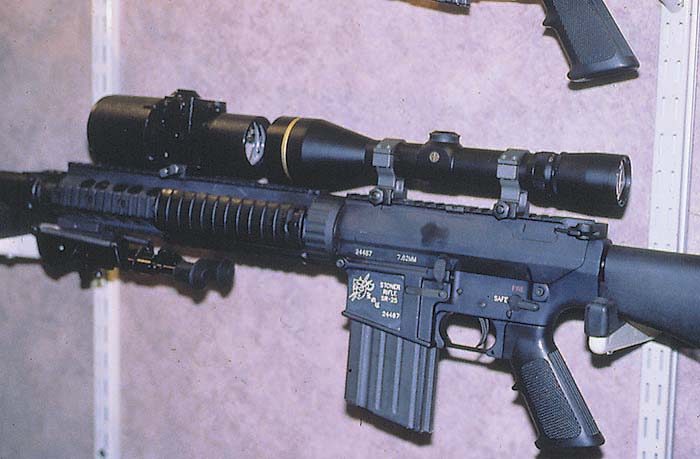
Generally Speaking…
The symposium kicked off as usual with a series of presentations by General officers of the Army and Marine Corps. Brigadier General John Geis, commanding general of ARDEC, and Major General Roy Beauchamp of TACOM, set the stage with an overview of how the Army identifies small arms needs, solicits scientific and industry input, then fields launchers, ammo and related items intended to meet those needs. Doing more with less and less was a common theme as these organizations struggle to overcome years of crippling budget cuts and bleak prospects for the near future despite the Republican congressional leadership’s pronouncements to the contrary.
Brigadier General Thomas Jones of the Marine Corps’ Combat Developments Command provided an amphibious warfare and urban combat perspective. The Corps, he predicted, would increasingly be in the business of fighting in cities since most of the world’s population was concentrated along ocean shorelines. He called for innovative solutions to unique problems such as urban navigation, locating and identifying enemy forces, as well as lethal and non-lethal means of clearing areas a building and a block at time.
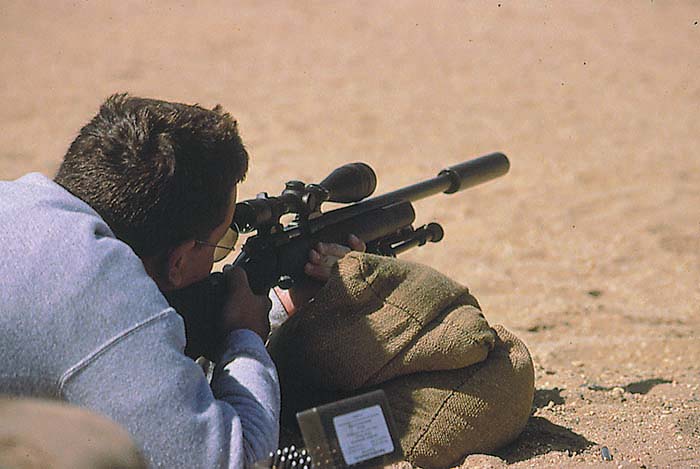
Breakout (and run)
There were so many papers that deserved hearing this year that organizers were forced to break up subsequent proceedings into three tracks; small arms, Military Operations in Urban Terrain (MOUT), and a bit of a catchall under Special Presentations. Since cloning of writer/photographers is (some say thankfully) not yet perfected, most of this report will concentrate on small arms highlights.
Master Plan
Army Lieutenant Colonel Bud Irish, for several years ARDEC’s Program Manager for Small Arms, and Joel Goldman of the Joint Service Small Arms Program (JSSAP), presented an overview of current and near future developments. Among other notable initiatives they highlighted the search for an off-the-shelf .50 caliber sniper rifle, a standardized shotgun for all of the Armed Forces, and “smart” grenade launchers like the Objective Individual Combat Weapon (OICW) and the Objective Crew Served Weapon (OCSW).
Irish laid out the realities of PM Small Arms activities in a matter-of-fact way, noting that work on the new 40mm infrared illuminating round and several other important infantry tools could not be finalized because the necessary money had not been appropriated by congress. Then, with perfect timing, he generated knowing laughter from armaments development professionals in the audience with the wry observation that the elusive miracle metal “unobtanium” was just what was needed to stretch pathetically small developmental budgets to cover what is clearly needed in the near future.
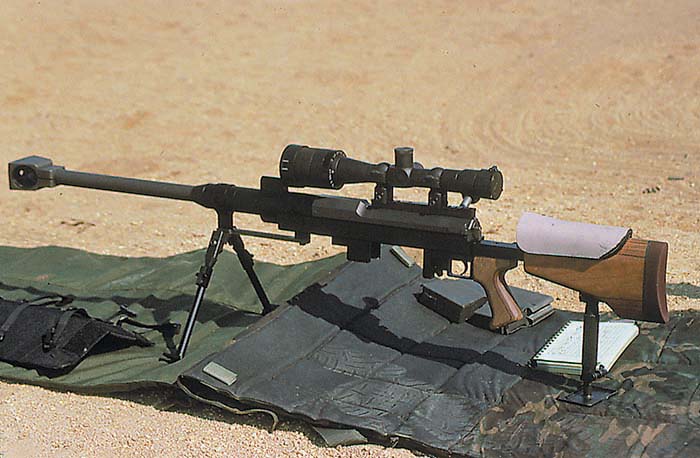
Long Range Sniper Rifle
In May of this year the Army selected a modified version of the Barrett Model 95 as its XM107 Sniper Weapon System. This bolt action .50 caliber rifle is intended for antipersonnel tasks out to 1500 meters and anti-materiel work at even greater range. According to Barrett’s George Kontis, production is on schedule and Army Spec Ops units should be getting their new fifties early next year.
Hand-in-hand with this is the Army’s search for suitable cartridges for these purposes. PM Small Arms expects to begin evaluating bids and samples later this year and make a selection early in 2000. Accordingly, several companies were in attendance to show off their candidates including Winchester/Olin with their MK211 multipurpose, M962 SLAP, and previously unknown Long Range Sniper Ammo (LRSA).
The French firm of PGM Precision, makers of the impressive Hecate II 12.7 x 99mm (.50 cal.) bolt action rifle was represented by New York based Drake Associates. This rifle, currently in service with the French Army, was on display in conjunction with the interesting Anthena PPI-AP brass sabot cartridge which was to figure prominently in Thursday’s live fire.
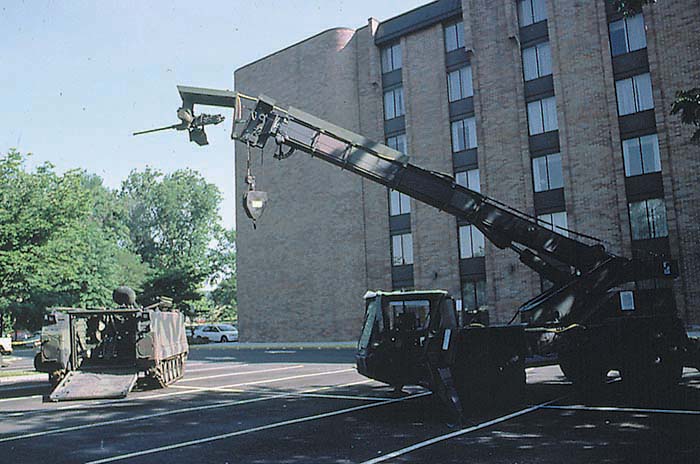
Shotgun News
There are at least four different shotguns in use by various branches of the US Armed Forces, a situation that fosters inefficiency in procurement, supply, training and maintenance. Matthew Zimmerman of the Joint Service Small Arms Program (JSSAP) introduced a cure for these ills in the form of XM1014 Joint Service Combat Shotgun. Capping an intense test and evaluation process, the Heckler & Koch/Benelli candidate was recently selected and a batch of guns has been delivered for “wringing out” in operational *testing. John Meloy of H&K’s Federal Operations says he’s confident that full production will soon be authorized, resulting in delivery to soldiers, sailors, airpersons and marines next year.

Starship Troopers
There was standing room only in the large lecture hall and people spilling out into the corridor when the real star of the conference was introduced. ARDEC’s Steve Mango and Alliant Technology’s Sharon Boone presented a comprehensive look at the capabilities of the SABR, or “Selectable Assault Battle Rifle.” Alliant is the prime contractor for this innovative assault rifle/grenade launcher also known as the OICW “Objective Individual Combat Rifle.” Heckler & Koch makes both the grenade launcher and the assault rifle components, with the last based on their superlative 5.56mm G36.
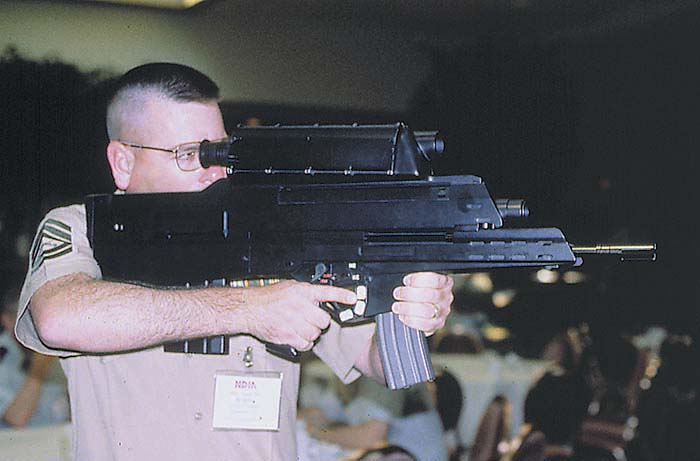
Already having satisfactorily demonstrated the extraordinary capabilities of SABR’s “smart” grenade launcher, fire control and 25mm ammunition, Alliant had just delivered six production prototypes to ARDEC for troop testing. If all goes well with the planned schedule of testing, modification, and improvement as emerging technologies are integrated along the way, SABR should be in the hands of line infantry units by 2007. This is not all that far away given the realities of peacetime R,D&A.
Is Paris Burning? Amusingly, the French just can’t seem to help themselves when it comes to reinventing the wheel. No matter how many times they have tried and fallen short of improving on existing weapons (nearly always) they steadfastly refuse to buy from other nations. The latest case in point was detailed by Retired French Army Colonel Guy Rageot, now with GIAT Industries, in a paper on how their FAMAS assault rifle (only slightly more successful in export sales than the sad British SA80) is in the process of being belled and whistled as a Gallic OICW.
As can be seen in the accompanying graphics from his lecture, the GIAT ICW “Individual Combat Weapon” of the future is a bullpup over/under 30mm grenade launcher/5.56mm assault rifle with on-board fire control that feeds into a helmet mount display. It sure seems to me that they could save a lot of time and francs by signing on to buy the American SABR. But then, the French consider Jerry Lewis to be a cinematic genius….
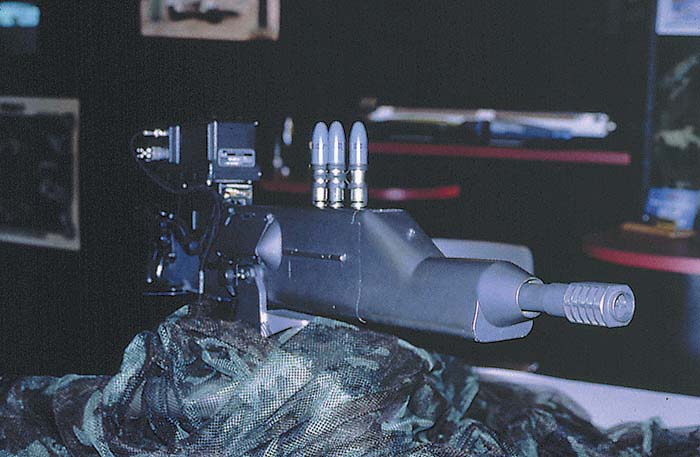
Crew Call
SABR’s big brother is the OCSW “Objective Crew Served Weapon” a 25mm automatic grenade chunker that also takes advantage of computerized fire control and inductively set “smart” fuze technology. ARDEC’s John Cline provided an update on the status of this exciting weapon that is intended to replace the decades old .50 cal. M2HB and the heavy and sometimes cantankerous 40mm Mk19 on ground and vehicle mounts within five years.
Beam Me Up
The science fiction of today is in danger of being overtaken by some fascinating experimental programs unveiled at the conference. It has been said that we are nearing a finite level of development for manportable kinetic energy weapons (conventional small arms and ammo) so visionary engineers are pushing the envelope along a variety of other interesting avenues.
**Gratuitous rant follows; However, others convincingly argue that this is largely due to the spreading infection of “political correctness” as America’s 60’s peacenik civilian leadership sends our Armed Forces on ill-considered, feel-good missions worldwide; putting them into danger but handcuffing them with unrealistic restrictions on the use of necessary force. It can’t be denied that the scramble for non-lethal means of dealing with our enemies has diverted appalling amounts of scarce money from traditional weapons upgrade programs. Hell, the Army and Marines don’t have enough basic small arms ammo to conduct much needed sustainment training! The full costs of this Clintonista soldierphobic arrogance and willful stupidity will undoubtedly be paid in American lives when the next inevitable high intensity war takes place. (End of gratuitous rant**)
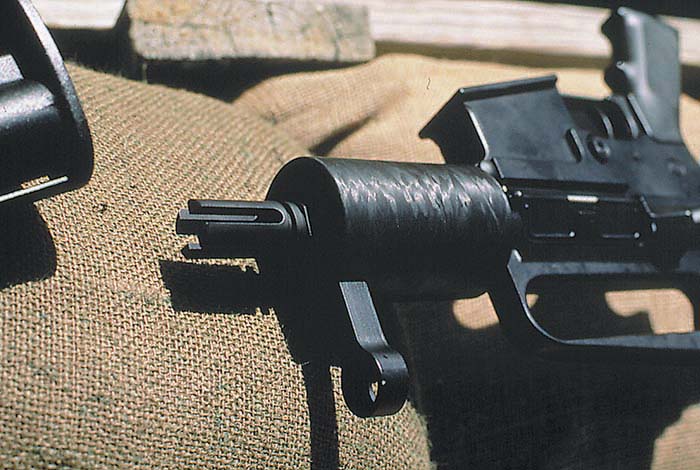
Editor’s added rant: (While it is not the editorial policy of SAR to slam politics, many of us are veterans of the various services. We understand the mission of the soldier on the field, of the sailor at sea, of the airman in the air, as being essentially the same; to fight the battles this country sets out for them. All too often we hear the horror stories of the active duty personnel that we work with, and how their preparedness and ability to do their jobs is suffering from the current administration’s policies. If reading that makes you uncomfortable, imagine how it must feel to be in harm’s way with the current politically correct dogma clouding up your mission and putting you at risk. Go Robert… Rant on this one for sure!- Dan)
Army Research Lab’s Louis Jasper showed three semi-amusing programs that appear to have their major practical applications in domestic law enforcement or as lawsuit bait for ACLU attorneys. (So, why aren’t Justice Department funds being spent instead of the Defense Department’s money?)
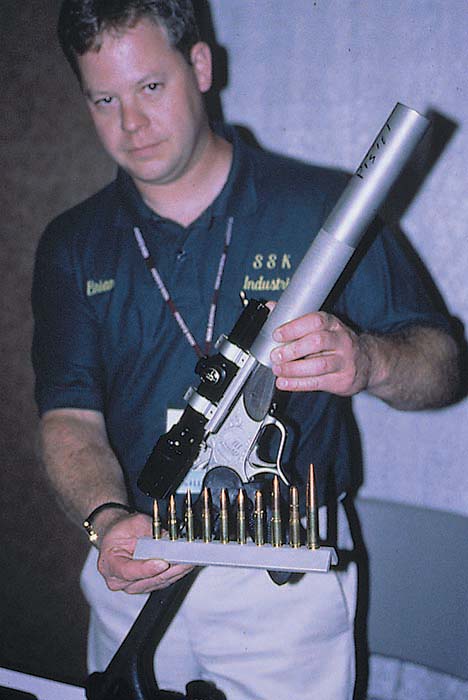
Don’t want to shoot up an approaching truck full of high explosives because the suicide mission terrorists inside might be harmed? Well, the Directed Energy Vehicle Stopper System “shoots” pulsed microwaves into a target vehicle where they go to work on electronic boxes and wiring to slow or stop the engine.
Want to disperse a crowd of demonstrators without tear-gassing the CNN camera crew that’s giving them worldwide publicity? The Electrical Driven Acoustic Source Experiment is a sound cannon that makes it very uncomfortable for people to hang around inside the range fan. One wag suggested that the same thing can be accomplished by playing rap music on a big boom box. Or, depending on the type of Third World dungheap agitators, playing anything by Ludwig van Beethoven …
Jasper’s last and perhaps most interesting program is the Vortex Ring Gun System, designed to efficiently propel an incapacitating agent with the energy shock wave produced by firing a large caliber blank. A diverging nozzle in the device forms the atomized chemical and shock wave mix into a high speed doughnut-shaped cloud with a 50 meter range —sort of a smoke ring from Hell.
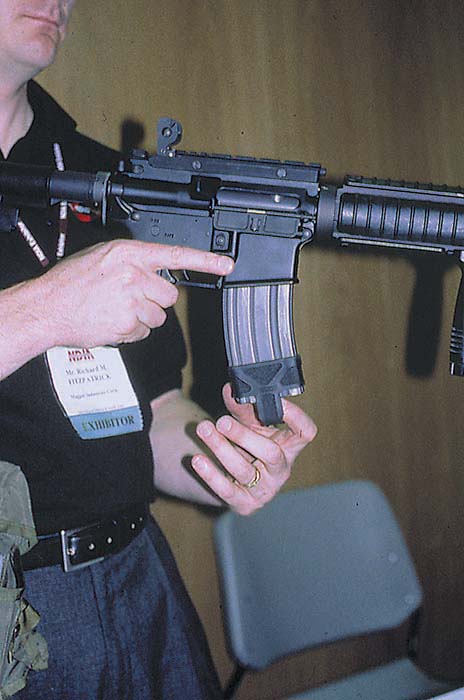
As seen in the accompanying illustrations, successful tests have been conducted showing the capability of knocking down a 150 lb. mannequin at 30 ft. One goal of the continuing experiment, says Mr. Jasper, is to develop a multi-shot device possibly based on the drum fed GL-6 40mm grenade launcher (Or the Manville Gun of “Dogs of War” cinema fame).
Army After Next
While some may make fun of “think tanks” with “eggheads” sitting around coming up with pie in the sky ideas, I humbly suggest we should all be grateful for guys like Dr. Stephen Small of JSSAP. Small’s presentation, entitled “Light Fighter Lethality After Next,” was a quick look inside an elite group of armaments-oriented scientists and experienced military professionals who are charged with laying groundwork for arming the future soldier.
This is an ongoing program designed to project emerging technologies some decades ahead. It seeks to guide development of weapons that can be barely imagined right now but are firmly rooted in the reality of technological probability.
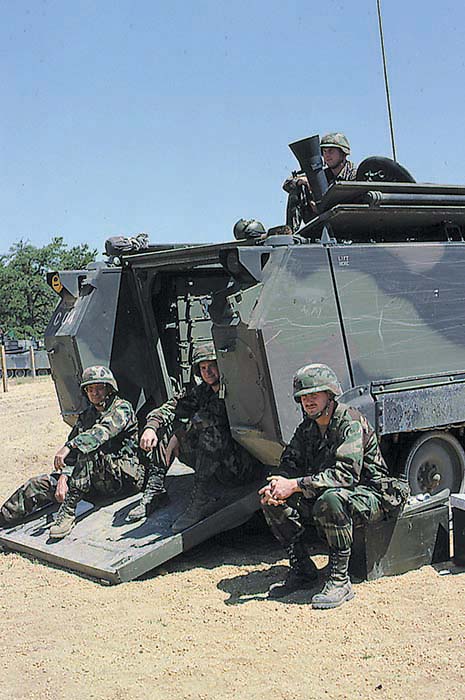
The “Seeker Projectile” is a case in point, envisioned as a small, light, wrist mounted device that launches a very smart round. The little warhead is a subminiature cruise missile that will know what it needs to hit as it leaves the launcher and will fly all by itself in whatever path needed to hit the target! Don’t laugh, just two decades ago in 1979 would you have believed that “smart” programmable airburst grenade launchers like the SABR and OCSW would be successfully tested and economically feasible by 1999?
Naysayers abound and — with the hard earned conviction of bloody experience in the real world — they insist that all of this is just flapdoodle. Put your trust in tough, motivated, well trained and brave Ranger type soldiers, they say. Wars, big and small, are won by men with simple, rugged and reliable weapons who will meet and defeat the enemy at close range on his own ground and under the worst possible conditions. “Hoo-aahgh!”
But sadly, the supply of these Ranger type soldiers is getting smaller by the minute in a soft and valueless America and in most of the rest of the “free” world. The heroic generation that won WWII is almost gone now and few since meet the standard they set. Realists know that America must use its technological edge to stay ahead of the likes of real warriors like the Mujahadeen and fanatical North Korean commandos.
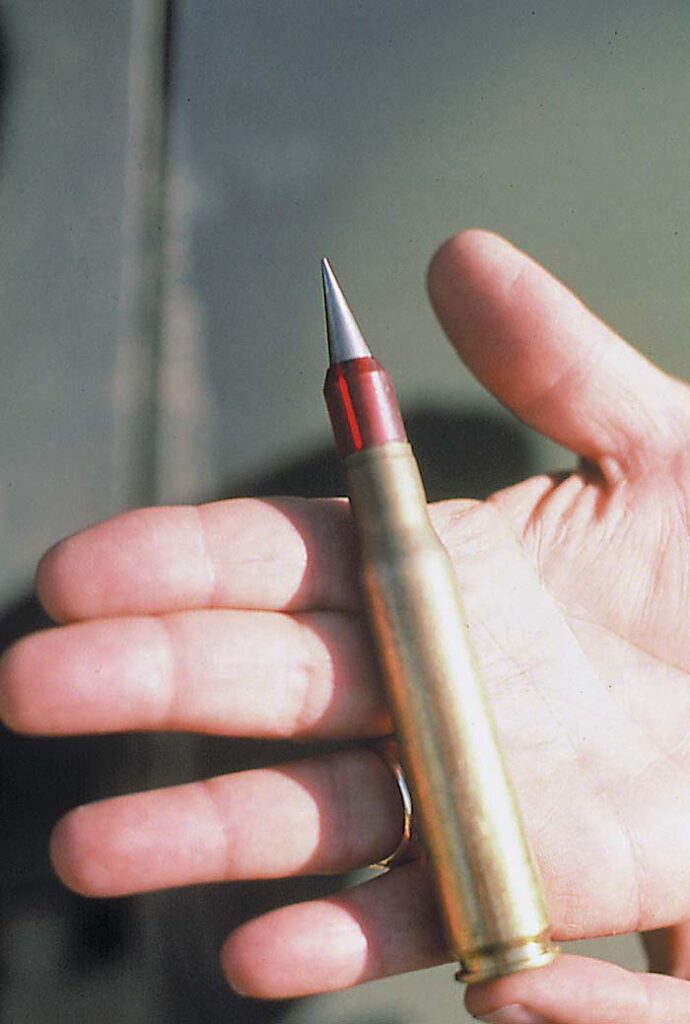
We take at least a small measure of comfort in the belief that effective kinetic energy weapons like the M16A2 and the M249, and those that fire “dumb” bursting munitions like the M203, are already on hand in great numbers. We can rely on them to work as well or nearly as well as those of our likely enemies in the mud, rain, snow, sand and dust anywhere on our planet anytime in the next 20 years.
Meanwhile, Dr. Small and others at the Light Fighter Lethality (LFL) project are committed to guiding scarce developmental monies toward the most likely avenues of dramatic improvement in the ability of “Land Warriors” (and probably Land Warriorettes) to dominate the future battlefield at long and close range.
(Oh, please don’t tell the Rangers that LFL is programmed to have more than $9 million for gathering and thinking over the next five years while Rangers, SF, and Marine Force Recon have to beg for enough training ammo to maintain basic proficiency….)
Hand Grenade Sit-ups?
It is endlessly fascinating to behold the ingenuity shown by persons of the engineering persuasion in developing new ways to kill, maim, or otherwise incapacitate their fellow humans. Thank God for them and for the fact that many are on “our” side.
In the category of “Why didn’t I thank of THAT!?” is the information contained in one D.W. Leeming’s paper with the intriguing title “Application of an Innovative Grenade Warhead to Defeat Combat Body Armor.” Mr. Leeming, an engineer with the British firm of Numerica Ltd., described the results of recent practical testing and computer modeling carried out in a joint experiment with Royal Ordnance. This was directed toward the goal of maximizing efficiency of the lowly hand grenade which has remained essentially the same since the 1800’s. The problem, he explained, is that traditional grenades are sadly ineffective against GI type Kevlar vests and similar body armor. And beside that, their fragmentation pattern is grossly inefficient.
Numerica’s solution, somewhat awkwardly named the Next Generation Hand Grenade, is to attach an uprighting mechanism consisting of a symmetrical series of spring loaded legs around its base. Four seconds after being thrown, when the grenade is likely to have come to rest near the target, the legs snap down and push the grenade body upright. A half-second later it detonates, sending fragments in a highly efficient pattern radiating out from the body with few chunks wasted going up into the sky or down into the dirt as in conventional designs. Diabolical!
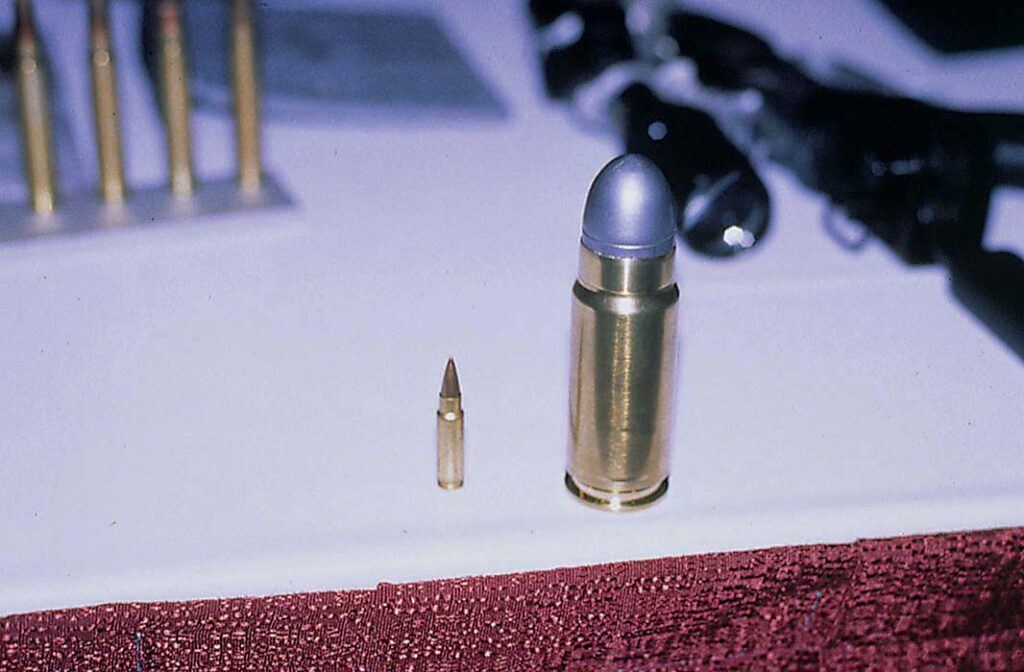
MOUT
Anticipating the request by Marine General James and many, many others, ARDEC has long been working on items designed to substantially increase the effectiveness of American fighting men in Military Operations in Urban Terrain (MOUT). ARDEC’s Colonel Gary Payne listed eleven initiatives in various stages of development including more non-lethal munitions (stun grenades, etc.) devices to breach thick barricaded doors or reinforced concrete walls, remote detonation of booby traps, and even safe 5.56mm ammo for realistic training in urban combat.
Many of these, Col. Payne pointed out, are available now “off the shelf” from private industry, but he challenged the attendees to come up with new solutions. This is a wide open field for developments that will undoubtedly have endless applications in urban law enforcement.
(Again the question arises of why DoD is having to fund this out of its pathetically meager budget when Janet Reno’s Injustice Department is flush with cash.)
Past as Prologue
In contrast to the many somewhat dry technical papers being presented by engineers, marketing types and others, came a cautionary tale of real urban warfare by a Marine who had been right in the middle of it. Nicolas Warr, author of the book PHASE LINE GREEN, was a 2nd Lieutenant commanding a platoon of Company C, 1st Battalion, 5th Marines in Vietnam during the notorious Tet Offensive. His vivid and insightful paper “Operation Hue City — Lessons Learned” laid out many of the challenges that are just as valid in MOUT today as they were back in 1968.
One particularly relevant aspect of the battle was the effectiveness of what Warr called “killer teams” made up by pairing a heavily armored M48 tank with the lightly armored but heavily armed Ontos. The tank could maneuver with relative invulnerability while drawing enemy fire. Sitting back in a safe overwatch position, the Ontos’ crew could spot where the fire was coming from and almost instantaneously wipe out the source with up to six 106mm recoilless rifle rounds. It is food for thought that there is nothing comparable to the Ontos in today’s Marine Corps as it wrestles with the probability of more urban combat missions.
Exhibits
Both large and small firms as well as government agencies traditionally show their capabilities and wares in exhibit booths around the perimeter of the lecture halls. These are where one can meet real designers and builders and actually put your hands on guns, ammo, sights and related systems. Many of these displays showcased items that were being introduced at the symposium in technical papers and would also be demonstrated later in the week on the range at nearby Ft. Dix.
Some highlights include the previously mentioned OICW from ARDEC and Alliant, H&K’s XM1014 shotgun and UMP45 submachine gun, Reed Knight’s SR-25 Lightweight Match Rifle, and just outside the exhibit hall, ARDEC’s remarkable high lift gun platform.
This last is a clever blending of developmental programs for remote-controlled weapons and a standard issue crane as used by certain specialized units of combat engineers. Called the Counter Sniper Weapon, it features a classic .50 cal. M2 HB machine gun with side mounted tele lens video camera that is aimed and fired by an operator using a video screen and joystick. Its unique usefulness comes in being able to lift it high above the battlefield —over the roofs of buildings or thick tree lines — to quickly dispatch enemies without actually exposing the human operator.
Its advantages in urban combat were particularly obvious where it was parked just outside the Parsippany Hilton. Had this been the Baghdad Hilton, the lift arm could take the gun right up to the highest floor to find adversaries with the video camera or thermal sight, then take them out with a devastating burst of .50 cal fire. Obviously, other weapons can be substituted as called for by the tactical situation.
Demonstrations
Another big difference between NDIA’s conference and others is the live fire portion, coordinated and conducted quite ably again this year by FNMI’s Sal Fanelli. According to Fanelli and Russ Logan, there is no comparable professional forum in which many of the same items presented in technical papers and exhibits are also shown in action on a range.
“It’s one thing to hear about a weapon in a nice, air-conditioned auditorium the way we do it and the Brits do it at Shrivenham (UK),” Logan says. “But, that’s nothing like the real world of the muddy boots soldier. Sitting uncomfortably in the bleachers in 90 degree heat watching actual weapons being fired is a very different reality.”
This “very different reality” can quickly alternate between fun and farce as Murphy’s Law (Whatever can go wrong will, and at the worst possible time) randomly asserts itself. Semi and full auto guns that worked perfectly well earlier in the day in function tests sometimes pick the worst possible time to jam up and refuse to fire. Sights that were perfectly zeroed a mere hour ago suddenly lead the shooter astray from heat mirage or a brisk crosswind. As embarrassed and uncomfortable as these and other mishaps may make the demonstrators, at least they don’t face — as a soldier does — the very real prospect of death because his gun won’t work at the critical moment!
This year the NDIA live fire included impressive demonstrations by nine domestic and international firms and closed with a spectacular presentation by the National Guard’s 42nd “Rainbow” Infantry Division.
In what may be thought of as the ultimate .50 caliber sniper rifle, an M1 Abrams tank crew from A Troop, 2nd Battalion, 102nd Armor of the New Jersey National Guard, fired several rounds of Winchester/Olin M962 SLAP-T (Saboted Light Armor Penetrator-Tracer) ammo from an American Apex Corp. (Columbus, OH) Aimtest subcaliber device inside the Abrams’ 105mm main gun. The gunner got a first round hit as the dart-like penetrator streaked out to 1500 meters and slammed into a tank hulk, showing not only the effectiveness of the SLAP-T, but also the efficiency of the Aimtest device as a low cost training device.
Representing France’s PGM Precision, Drake Associates (Islip Terrace, NY) fired the French Army’s .50 caliber Hecate II bolt action with Anthena PPI-AP ammo, reportedly putting seven rounds inside the perimeter of a 14 inch/___cm tire rim at 1150 meters. Bob Drake says the brass sabot Anthena cartridge is being evaluated by the Army for standardization in the Long Range Rifle program.
SSK Industries (Wintersville, OH), is famed for its “Whisper” line of subsonic ammo and astonishingly big custom handguns. Owner J.D. Jones, a guy with a great sense of humor and boundless firearms expertise, demonstrated both by popping metal plates — the sound of impact splatter was louder than the firing of the weapon — and lighting up a derelict tank with spectacular pyrotechnic effects from incendiary loads. Call SSK if you want to kill, clean, and cook a Kodiak Bear with one shot….
Well known scopemaker Trijicon was represented by former Army Special Forces Lieutenant Colonel Mike Harris, now retired and head of Special Analytical Services (Dover, FL). Mike demonstrated several of Trijicon’s specialized optics on their appropriate weapons including a carbine, assault rifle, and squad auto weapon. “Murphy” got him right at the end of an otherwise flawless demo when his M249 jammed.
Christensen Arms (Fayette, UT) pressed longtime shooter, NDIA member, and cartridge guru Jim Frigiola into marksmanship duties with their light and highly accurate CarbonONE rifle. Jim repeatedly “gonged” a steel plate set 400 meters downrange, validating the rifle’s graphite/epoxy sleeved stainless steel barrel.
Swiss Munitions (Thun, Switzerland) took the prize for the most elaborate target preparation by lugging two identical body armor sandwiches more than 200 meters downrange (carefully stepping around 40mm duds) in preparation for a dramatic penetration test of their 7.62mm SWISS-P AP tungsten carbide cartridge. Franco Wagner dropped down behind a beautiful ERMA SR 100 sniper rifle and put three rounds of new Army standard armor piercing M993 into one sandwich, then three SWISS-P rounds into the other. Later on, after the range was closed to firing, they lugged the armor back to show unmistakably that their round outperforms what our GI’s are issued.
The red polo shirt uniformed Gemtech (Boise, ID) demo team, led by Doc Phil Dater, put several of their excellent suppressors to the test, a welcome opportunity for the audience to remove their earplugs and marvel. Depending on your choice of launch platform, choose the “Raptor,” “Predator,” or “Mossad” for close range critical applications.
While the M16 family of weapons has been around for decades and is now made quite well by a whole bunch of different manufacturers, M2 Corporation (Las Vegas, NV) has some executive security variants of the M16 that command immediate attention. Mark Pierson conducted an astonishing torture test of the 8 inch barrel M16S by hosing 500 rounds downrange in continuous full auto bursts from five BETA C-MAGs. “Murphy” was thwarted as this went off without a hitch and the smoking barrel and handguard refused to melt. The laws of physics decree a catalog of reasons why accurate and effective .30 caliber subsonic rounds are nearly impossible to build with consistency and economy. Engel Ballistic Research (Smithville, TX) seemingly defies these laws with two rounds that have been snatched up by some big players in the special operations business. Former USMC Scout Sniper Dan Nafe demonstrated Whit Engel’s unjacketed 7.62mm/.30 cal “Thumper” and new jacketed PBS (Precision Bonded Subsonic) rounds, ringing a 3 inch square steel plate placed some 75 meters downrange.
Mad Minute and More
The industry show was immediately followed by an impressive twenty minute live fire demonstration by Guardsmen of the New Jersey and New York National Guard’s 42nd Infantry Division (Mechanized).
Intended to show how dismounted infantrymen are supported by the organic heavy weapons of a modern mechanized infantry battalion, the show began when two rifle squads double-timed out and jumped into sandbagged fighting positions directly in front of the bleachers, then locked and loaded M16’s and M249’s. Heavier weapons were positioned on a long line to their right, including 7.62mm M60 and .50 caliber M2HB machineguns, 40mm MK19 grenade machine guns, and two M113A4 mortar carriers.
The tactical scenario called for the squads to spot an enemy mechanized infantry unit moving their way and to call for appropriate elements of fire support beginning at 4000 meters. Starting with the long range 120mm mortars, each group of heavy support weapons fired in turn. Finally, it was time for the riflemen to deal with some amazingly hardy survivors who had miraculously closed to less than 300 meters despite the cumulative effects of successive crew served weapon bombardments.
The riflemen and machinegunners made short work of the invading foot soldiers — represented by a bunch of prepositioned Type E silhouettes — with a storm of 5.56mm ball and tracer crisscrossing the immediate range front and thoroughly air conditioning the “enemy.”
These young men and countless others in American uniforms are, after all, those the Small Arms Section is pledged to support now and in the future. Keep at it guys, there is much work that remains to be done and new generations are going to need everything you can come up with.
| This article first appeared in Small Arms Review V3N11 (August 2000) |



